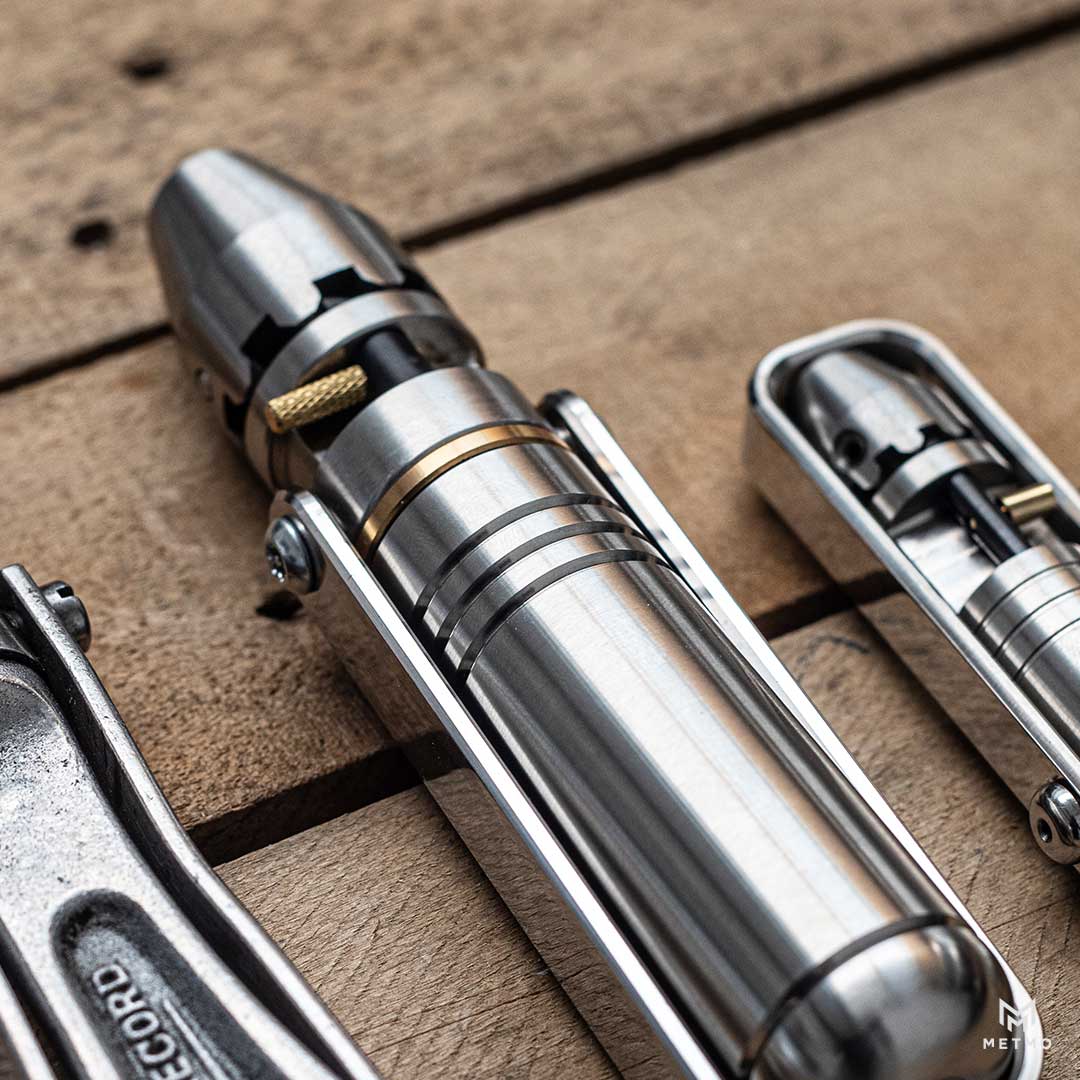Hello Again,
We thought we'd do a good old-fashioned strip down of the Pen and run through each part for you, giving a real detailed behind-the-scenes view of what goes into each part of our designs.

The Ejector

We start with the humble ejector. We made the call to go for a twist ejection method over a clicker very early on. As much as we love furiously clicking Pilots until someone loses it and throws the remote at you... we just couldn't stop playing with the silky smooth M10 thread we built into the pen. My favourite thing to do right now is use a nut to eject the nib. Maximum satisfaction.

The ejector is machined from solid brass or aluminum and is a very specific weight to ensure we get the balance of the pen correct. Too heavy at the nib and it becomes difficult to write with, too heavy at the other end and it's almost impossible to write more than a few sentences.
The ejector is designed to be very universal and allows us to use refills like the Fisher Space Pen and other popular cartridges.
The Twisty Bits

AKA the multi-start opposing thread nuts. As with everything on MetMo Pen, these components have to be beyond silky smooth to ensure they can glide along the shaft with minimal resistance. You can see the surface finish on the inside of the nuts is nice and shiny and free from any burs or imperfections. Anything less than perfection on these guys would negatively impact the fiddle factor of the entire pen, so we ensure they are machined painstakingly slow which allows the machinist to achieve such a high quality finish without any second operations.
You may be wondering, why so many threads?
This technique is used to create components called lead screws which are found inside machines like 3D printers. These ensure pin point accuracy across a large area as the extra threads create a much larger contact area which helps to remove any play in the design and when combined with the correct materials, this reduces the amount of total friction in the mechanism, massively improving its efficiency.
We have used this same technique in MetMo pen to make sure you are getting the maximum dose of satisfaction possible, with each turn of the nut.
The Glorious Shaft

The real star of the show. Machined from a rod of 6061 aluminum or solid brass, the main section of the pen takes a small age to produce due to its intricate nature, but once complete, the finish is spectacular!
The thread pattern is very unique and from afar could easily be mistaken for standard knurling, but get closer and you can see an intricate array of carefully machined threads laced around the shaft. We spent many weeks perfecting the exact pitch and profile to use, as using the incorrect pitch would either cause the nuts to not move at all or hurtle towards the desk at the speed sound!
The overall profile of the pen was very important to get right too, as it became very apparent that this pen could easily look like a bit of a chunk if we weren't careful! We wanted the pen to look as sleek as possible whilst still being as fiddly as it could possibly be, so each curve and taper has been carefully considered and perfected over many many prototypes.

Looking closely at the pattern on MetMo Pen, you can start to appreciate the intricate machining work that goes into creating it. This is quite far from your standard thread cutting machine!
After we perfected the function and aesthetics, we had to make sure the pen was actually comfortable to use! The tiny peaks the thread cutting creates have been gently polished and the sections which you grip have been tapered off into the completely smooth nib zone. We wanted to toe the line between gentle tactile feedback and a comfortable writing experience to get the best of both worlds with MetMo Pen.
We've been asked a few times if the MetMo Pen is sharp to hold and the best we can compare it to is, do you remember those old pin art displays we used to play with as kids? It doesn't hurt, of course, and feels really satisfying to touch. That's the sensation we're re-creating here!
The Ink

We use a traditional oil-based ink, and the quality of the cartridge ensures no blotting with a smooth line weight from the moment you put pen to paper. The refills can be swapped out for a number of different cartridges like the Fisher Space Pen or a standard Parker refill. We're testing a number of other popular refills too, but the general rule is, if it fits a Parker, it'll probably work :)
The Sheath

The solid brass case has an awesome weight to it. Machined from solid hex bar, this thing is designed purely to look amazing on your desk.
This is also one of the most difficult pieces to machine. It has a very precise thread stop point to ensure the pen stops at exactly the right place, leaving just enough room to sit your nuts on top. The six-start thread proved particularly challenging to create inside a blind hole which has quite a deep engagement. Early on we were having issues with the pen becoming stuck halfway down, and it required a bit of persuasion for it to drop the whole way. Thankfully, with a bit of tolerance tweaking and slowing the machine down, we were able to ensure a smooth drop and a very satisfying 'clunk' as the pen drops to the bottom of the case.
We decided to only produce this case in brass as the weight of the aluminum just wasn't doing it for us, and focusing on ensuring the brass case functioned perfectly was a high priority for us.













